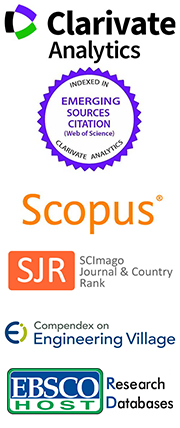Enhancement of Physical Properties and Energy Costs in Bagasse Pellets using Agro-waste Additive
Abstract
This study investigates the improvement of physical characteristics and energy costs in bagasse pellets using agro-waste additives. The additives were coffee grounds (CG) and corn cobs (CC), with varying proportions. The bagasse pellets were evaluated according to the standards set by the Pellet Fuels Institute. The results demonstrate that increasing the additive content significantly improved both bulk density and durability. The study revealed that the addition of coffee grounds and corn cobs at 5% improved the physical properties compared to no additives (0%). The bulk density values increased by 5.06% for coffee grounds and 3.13% for corn cobs. Furthermore, the durability values increased by 0.76% for coffee grounds and 0.37% for corn cobs. However, coffee ground additives enhance the quality of pellet fuel more effectively than corn cob additives. Due to the fine and uniform particles of coffee grounds, this results in reduced void spaces between the particles. Additionally, the coffee grounds act as a natural binder during the densification process, which enhances the durability of the pellets. It was shown that the energy costs associated with the production process of bagasse pellets using additives decreased. The reductions were 8.32% for coffee grounds and 7.55% for corn cobs. Thus, the agro-waste additives were coffee grounds and corn cobs, which improve the physical properties of the pellet. Additionally, the additives lower energy costs and enhance the performance of bagasse-based biomass pellets, providing an energy solution for a sustainable energy future.
Keywords
Full Text:
PDFReferences
Ostergaard P.A., Duic N., Noorllahi Y., and Kalogirou S., 2020. Latest progress in Sustainable Development using renewable energy technology. Renewable Energy, 1154-1562.
Kumar I., Feng K., Sun L., and Bandaru V., 2022. Adoption of biomass for electricity generation in Thailand: Implications for energy security, employment, environment, and land use change, Renewable Energy 195: 145-1467.
Chen C., Bi Y., Huang Y., and Huang H., 2021. Review on slagging evaluation methods of biomass fuel combustion. Journal of Analytical and Applied Pyrolysis, 155.
Dhyani V. and T. Bhaskar. 2018. A comprehensive review on the pyrolysis of lignocellulosic biomass. Renewable Energy, 219.
Unchaisri T., Fukuda S., Phongphiphat A., Saetia S., and Sajjakulnukit B., 2019. Experimental study on combustion characteristics in a CFB during co-firing of coal with biomass pellets in Thailand. International Energy Journal.
Kanoksilapatham W., Ogawa M., and Intagun W., 2020. Effects of clay and temperature on the slag formation of two biomass fuels: Wood from Acacia mangium and rhizome residual from Manihot esculenta. Renewable Energy 156: 213-219.
Kongchouy P., Tia W., Nathakaranakule A., and Soponronnarit S., 2021. Assessment of seasonal availability and spatial distribution of bio-feedstock for power generation in Thailand. BioEenergy Research, 1-21.
Chen X., Liang J., Liao P., Huang W., and Chen J. H., 2021. Effect of process parameters and raw material characteristics on the physical and mechanical quality of sugarcane bagasse pellets. Biomass and Bioenergy, 154.
Saosee P., Sajjakulnukit B., and Gheewala S.H., 2022. Environmental externalities of wood pellets from fast-growing and para-rubber trees for sustainable energy production: A case in Thailand. Energy Conversion and Management: X, 14.
Phiri R., Rangappa S.M., and Siengchin S., 2024. Sugarcane bagasse for sustainable development of thermoplastic biocomposites. Industrial Crops and Products, 222(5).
Singh P., Dogra P., and Kalamdhad A.S., 2024. Sugarcane bagasse and cow dung pelletization in varied food-to -microorganisum ratios for biogas generation. Industrial Crops and Products, 210.
Toscano G., Feliciangli G., Rossini G., Fabrizi S., Pedretti E. F., and Duca D., 2019. Engineered solid biofuel from herbaceous biomass mixed with inorganic additive. Fuel, 256: 1-10.
Rajput S.P., Jadhav S.V., and Thorat B.N., 2020. Methods to improve properties of fuel pellets obtained from different biomass sources: Effect of biomass blends and binders. Fuel Processing Technology, 199: 1-12.
Intagun W. and A. Maden. 2020. Effect of mixing ratios on physical properties and energy consumption of Leucaena pellets by using fermented cassava-rhizome. Science, Engineering and Health Studies, 14: 193-202.
Intagun W., Sonponpongpipat N., and Kanoksilapatham W., 2023. Fermented cassava-rhizome residue as a biomass pellet binding additive influenced by multi-bacterial biofilm. International Energy Journal 23: 219-228.
Zongliang Z., QingBo Y., X., Kun W., SiHong L., Fan Y., Qin Q., and ZhenFei Q., 2018. Mechanical and reduction characteristics of cold-pressed copper slag pellets composited within biomass and lignite. Renewable Energy, 125: 206-224.
Liu Y., Yan T., An Y., Zhang W., and Dong Y., 2021. Influence of water leaching on alkali-induced slagging properties of biomass straw. Journal of Fuel Chemistry and Technology, 49:1839-1849.
Lachman J., Balas M., Lisy M., Lisa H., Milcak P., and Elbl P., 2021. An overview of slagging and fouling indicators and their applicability to biomass fuels. Fuel Processing Technology, 217: 1-10.
Jezerska L., Sassmanova V., Prokes R., and Gelnar D., 2023. The pelletization and torrefaction of coffee grounds, garden chaff and rapeseed straw. Renewable Energy, 210: 346-354.
Ali A.M., Waheed A., Shahbaz M., Mirani A.A., Shahzad K., Zahrani A.A., Nawaz A.M., Mahpudz A.B., 2023. Synergistic evaluation of co-torrefaction performance of rice husk and coffee bean ground blends for biosolid production for industrial fuel sustainability. Fuel, 343.
Solowiej P., Neugebauer M., and Esmer O., 2024. Coffee grounds as additive to wood pellets. Energies, 17(18).
DOI: https://doi.org/10.64289/iej.25.03A11.6902771


